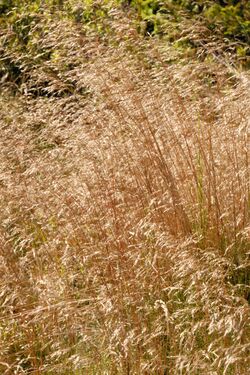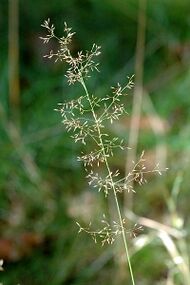Biology:Agrostis canina
| Agrostis canina | |
|---|---|

| |
| Scientific classification | |
| Kingdom: | Plantae |
| Clade: | Tracheophytes |
| Clade: | Angiosperms |
| Clade: | Monocots |
| Clade: | Commelinids |
| Order: | Poales |
| Family: | Poaceae |
| Subfamily: | Pooideae |
| Genus: | Agrostis |
| Species: | A. canina
|
| Binomial name | |
| Agrostis canina | |
Agrostis canina, the velvety bentgrass,[2] brown bent or velvet bent,[3] is a species of grass in the family Poaceae.
Description
Agrostis canina is a perennial plant, with stolons but no rhizomes, and culms which grow to a height of up to 75 centimetres (30 in).[4] It is frequently confused with Agrostis vinealis (formerly treated as a subspecies or variety of A. canina), which grows in more upland habitats and has rhizomes rather than stolons.[3]
The leaf blades are 2–15 cm (0.8–5.9 in) long and 1–3 mm (0.04–0.12 in) wide,[5] with an acute or acuminate ligule up to 4 mm (0.16 in) long.[4]
The plant flowers from May to July,[3] and the inflorescence is a panicle 3–16 cm (1.2–6.3 in) long and up to 7 cm (2.8 in) wide, with rough branches.[5] Each spikelet is 1.9–2.5 mm (0.07–0.10 in) long; the lemma is 1.6 mm (0.063 in) long with an awn attached around the middle.[3]
Distribution and ecology
The range of Agrostis canina covers most of Europe and temperate parts of Asia, and extends from sea level to the alpine zone.[6] It has also been introduced to eastern North America, Hawaiʻi, Algeria and the Kerguelen Islands.[1]
Agrostis canina is sensitive to drought,[6] but is common in damp places, including ditches and lake margins.[7]
The short, green growth of A. canina has made it popular as a lawn grass.[5]
References
- ↑ 1.0 1.1 Lansdown, R.V. (2014). "Agrostis canina". IUCN Red List of Threatened Species 2014: e.T167861A42382326. doi:10.2305/IUCN.UK.2014-1.RLTS.T167861A42382326.en. https://www.iucnredlist.org/species/167861/42382326. Retrieved 20 November 2021.
- ↑ English Names for Korean Native Plants. Pocheon: Korea National Arboretum. 2015. pp. 344. ISBN 978-89-97450-98-5. http://www.forest.go.kr/kna/special/download/English_Names_for_Korean_Native_Plants.pdf. Retrieved 25 January 2016.
- ↑ 3.0 3.1 3.2 3.3 Ann Fowler Rhoads; Timothy A. Block; Anna Aniśko (2007). "Agrostis L.". The Plants of Pennsylvania: an Illustrated Manual (2nd ed.). University of Pennsylvania Press. pp. 322 326. ISBN 978-0-8122-4003-0. https://books.google.com/books?id=TUVxB7goeV0C&pg=PA323.
- ↑ 4.0 4.1 Clive A. Stace (2010). "Agrostis L. – Bents". New Flora of the British Isles (3rd ed.). Cambridge University Press. pp. 1026–1030. ISBN 978-0-521-70772-5.
- ↑ 5.0 5.1 5.2 C. E. Hubbard (1984). "Velvet bent – Agrostis canina L. subsp. canina". Grasses: a Guide to their Structure, Identification, Uses and Distribution in the British Isles (3rd ed.). Penguin Books. pp. 294–295. ISBN 978-0-14-013227-4.
- ↑ 6.0 6.1 Alain Peeters. "Agrostis canina L.". Grassland Spsecies Profiles. Food and Agriculture Organization. http://www.fao.org/ag/AGP/AGPC/doc/Gbase/DATA/pf000417.htm.
- ↑ Carl Farmer. "Velvet Bent. Agrostis canina s.s.". West Highland Flora. http://www.plant-identification.co.uk/skye/gramineae/agrostis-canina-ss.htm.
External links
Wikidata ☰ Q159182 entry
 |



